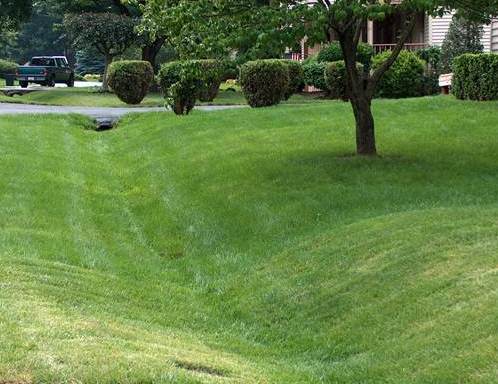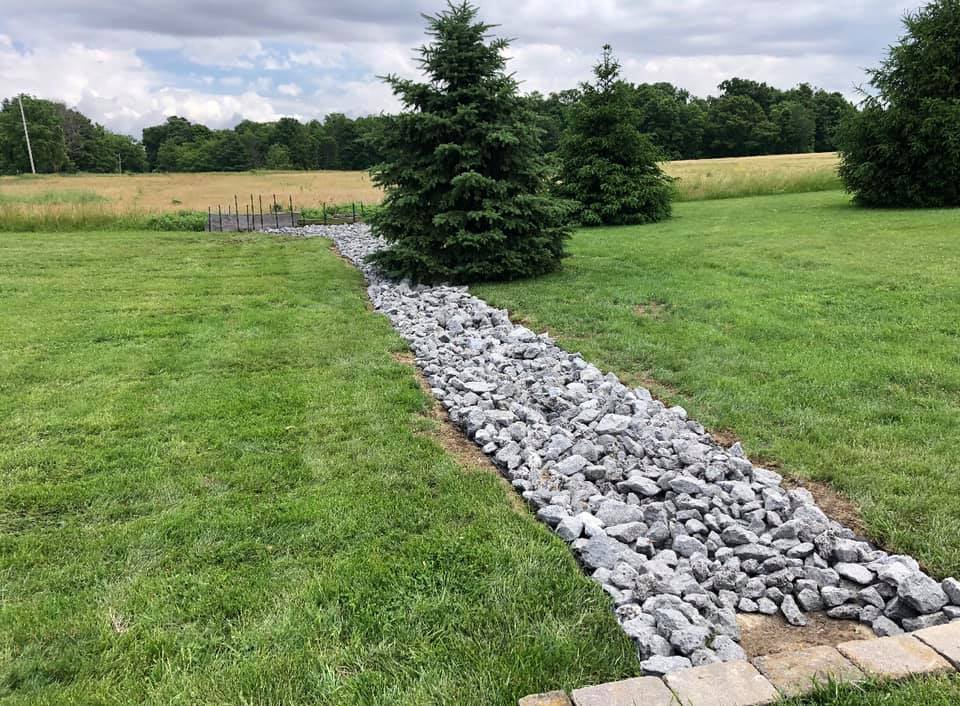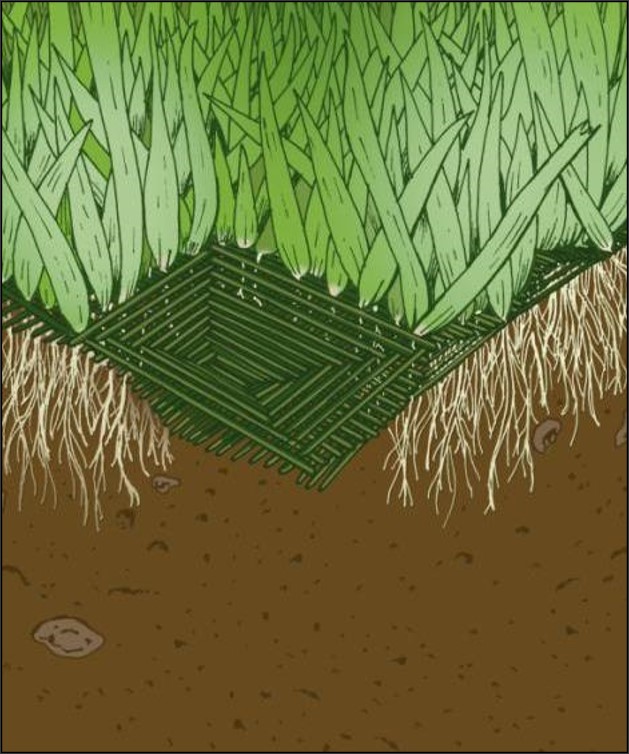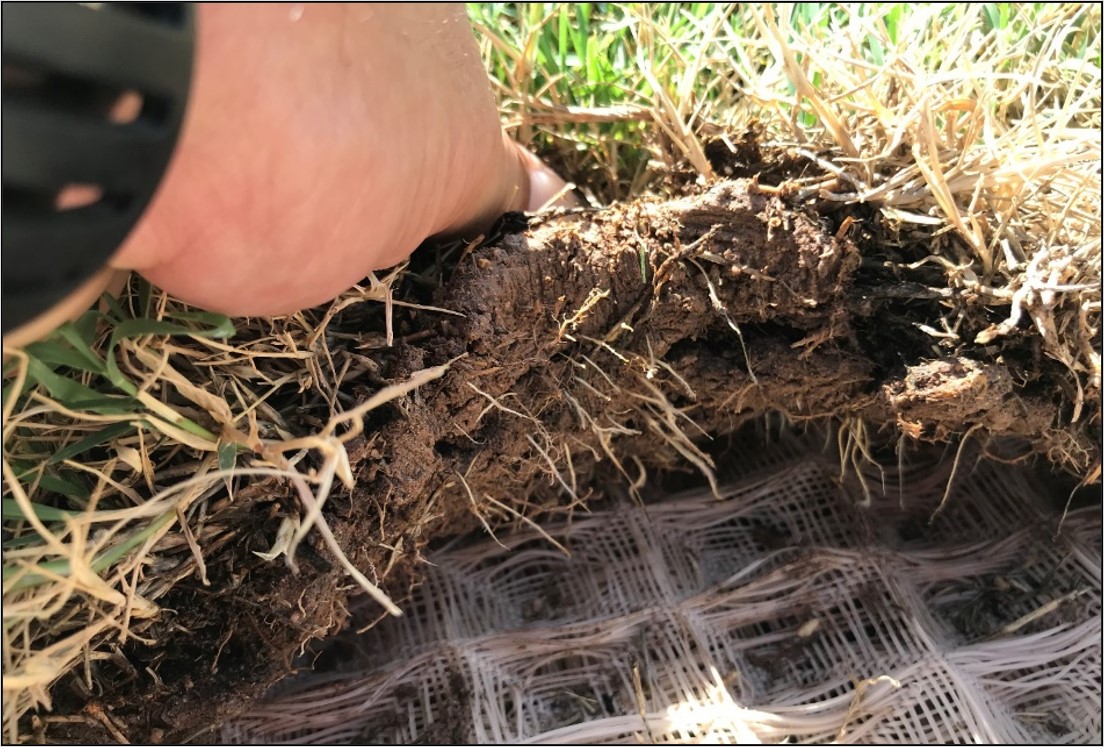Search for articles or browse our knowledge portal by topic.
Turf Reinforcement Mats

Channel with Grass Lining

Channel with Riprap Lining
Classified as rolled erosion control products (RECP), turf reinforcement mats (TRMs) combine vegetation and synthetic materials in the form of a high-strength mat to prevent soil erosion in drainage channels and on steep slopes. Compared to typical grass lined channels, TRMs are more resistant to the erosive forces of water.
Unlike temporary erosion control products (e.g., erosion control blankets), TRMs are designed to stay in place permanently to protect seeds, soils, and roots and to improve seed germination. TRMs are an excellent alternative to rock-lined channels, especially in developed areas. TRMs:
- Can be used on steep fill slopes to prevent erosion and improve stability
- Provide greater water quality benefits compared to rock lined channels
- Are easier to mow
- Allows grass lined channels to withstand a higher permissible shear stress when compared to other permanent linings such as rip rap
Applied shear stress (τd) is the force that flowing water exerts on the boundary of an open channel. As flow depth and channel slope increase, applied shear stress also increases. Higher applied shear stress results in greater erosion within channels and on steep slopes exposed to runoff.


During the KYTC design process, drainage channels are sized to convey the 10 year storm. Once a channel’s cross section and slope are known, applied shear stress is calculated based on maximum channel depth.
Permissible shear stress (τp) is the amount of force a lining material can withstand before it begins to erode. To ensure channel lining stability, it is critical to select a lining whose permissible shear stress is greater than the applied shear stress that will be exerted by water flowing in the channel.
KYTC uses TRMs as channel linings and on steep slopes to guard against erosion. The following documents summarize the Cabinet’s TRM policies:
- Drainage Manual Chapter DR-504 Channel Linings
- Joint Design (3-23) and Construction (01-23) Memo: Update on Use of Turf Reinforcement Mats (TRM)
- Special Note 11F
- Standard Drawing Sepias
Chapter 500 of the Drainage Manual discusses the hydraulic design of open channels. Section 505 reviews the design of channel linings. Table 1 lists permissible shear stress values for different types of linings.
| Table 1: Permissible Levels of Shear Stress for Channel Linings | |
|---|---|
| Table 505-4 Permissible Shear Stress for Flexible Linings | |
| Lining | Permissible Shear Stress, lb/ft2 |
| Grass Lining (Seed or Sod) | 1.0 |
| Turf Reinforcing Mat Type 1 | 6.0 |
| Turf Reinforcing Mat Type 2 | 8.0 |
| Turf Reinforcing Mat Type 3 | 10.0 |
| Turf Reinforcing Mat Type 4 | 12.0 |
| Channel Lining Class II | 2.5 |
| Channel Lining Class III | 5.0 |
| Channel Lining Class IV | 5.0 |
| Channel Lining Class IA (Mattress Units | 35.0 |
Taken from Table 505-4 of the KYTC Drainage Manual
If the designer chooses to use a TRM as a channel lining, they must (a) specify the type chosen in the plans and (b) include Special Note 11f in the contract documents.
Design methods described in the Drainage Manual are taken from the FHWA publication Design of Roadside Channels with Flexible Linings, Hydraulic Engineering Circular No. 15 (HEC 15).
Basic steps for installing TRMs in drainage channels and on steep slopes are summarized below.
4.1 Installation in Drainage Channels
- Grade and prepare soil surface
- Grade the channel to achieve a smooth surface. Remove large rocks, soil clods, vegetation, roots, and other sharp objects that could keep the mat from intimate contact with subgrade.
- Install TRM
- Construct an anchor trench upstream. The anchor trench is directly adjacent to the downstream end of the culvert headwall.
- Unroll the lining in a downstream direction starting in center of channel.
- Staple as the lining shown in sepia drawings.
- Overlap the center section of the lining over adjacent sections longitudinally.
- Overlap upstream sections of the lining on top of downstream sections.
- On side slopes, overlap higher sections of the lining over lower sections and construct an anchor trench at top of slope.
- Sow grass seed. The grass seed is placed on top of the TRM not underneath it.
- Cover mat and seed with ½” topsoil.
- (Optional) Cover with the lining with an erosion control blanket.
4.2 Installation on Steep Slopes
- Grade and prepare soil surface
- Grade the slope to achieve a smooth surface. Remove large rocks, soil clods, vegetation, roots, and other sharp objects that could keep the mat from intimate contact with subgrade.
- Install TRM
- Construct an anchor trench at the top of the slope.
- Unroll the lining in a downhill direction (i.e., down the slope).
- Staple the lining as shown in sepia drawings.
- Overlap higher sections of the lining on top of lower sections.
- Sow grass seed.
- Cover mat and seed with ½” topsoil.
- (Optional) Cover the lining with an erosion control blanket.
Drainage Manual. (2010). Kentucky Transportation Cabinet.
Erosion Control Technology Council (ECTC) Website
Design of Roadside Channels with Flexible Linings, Hydraulic Engineering Circular No. 15 (HEC 15). (2005). Federal Highway Administration.
HKP Article Erosion Control – Field Applications

